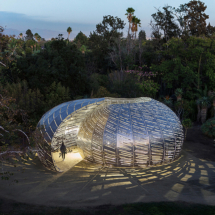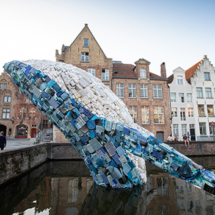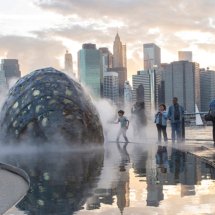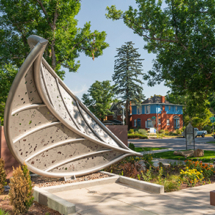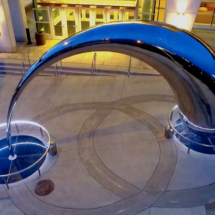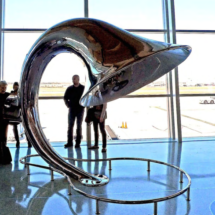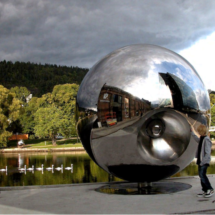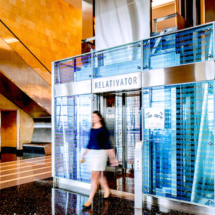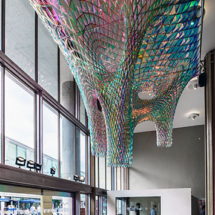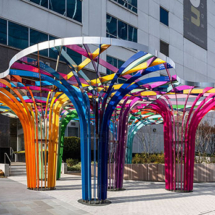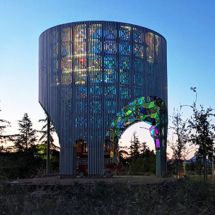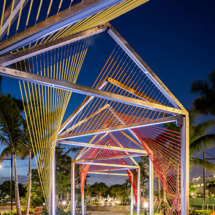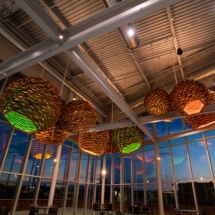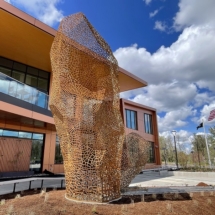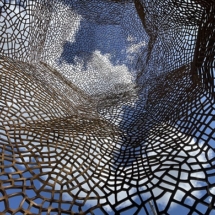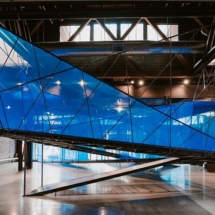
The School of Computer, Data & Information Sciences (CDIS) is one brushstroke closer to commissioning art for the northeast entrance to the new building opening in 2025. Four artists have been selected as semi-finalists who will propose artwork for the project.
Ninety-one applications were reviewed by the committee, which consists of Chazen Museum of Art Director Amy Gilman, Computer Sciences Professor Bilge Mutlu, Information School Professor Rebecca Willett, and CDIS Program Director Vasso Founta. The committee considered each artist’s or artist team’s experience, focus of art, and their passion for making a creative mark on our campus. In addition, the committee engaged faculty and staff throughout CDIS in determining who will be invited to create the piece that welcomes people to their new home.
The four semi-finalists include STUDIOKCA, Po Shu Wang, Michael Szivos and Clayton Binkley. Beginning this month, they’re meeting with the committee to better understand the project and community before developing their proposals. The semi-finalists will craft a detailed proposal for artwork including an itemized budget, scale models and renderings, timeline, and an in-depth project description. For this, they will be paid an honorarium of $5,000.
The finalist will be selected in April 2023 and the art will be installed prior to the new building’s opening in 2025. Learn more about the building that will act as a hub for collaboration, making every idea better.
Meet the Semi-Finalists
Jason Klimosky & Lesley Chang of STUDIOKCA
STUDIOKCA is an award-winning architecture and design firm led by Jason Klimoski and Lesley Chang based in Brooklyn, New York with projects ranging in scale and complexity from lighting fixtures and interiors, to public installations, sculptures and buildings across the globe.
Jason has the home field advantage as he grew up in Madison’s art culture. “Thinking back on some of my fondest memories, Madison helped form my appreciation for art, architecture, public space, and nature: attending Concert on the Square with my parents (and excitedly awaiting the 1812 overture to hear what I thought was real cannon fire); visiting Art Fair on the Square, and getting my first glimpses into the world of fine art photography and painting; hanging out at Memorial Union Terrace practically all summer; kayaking on Lake Mendota and Lake Monona, watching the water’s surface ripple with the wind.”
Po Shu Wang of Living Lenses
The artist based in Berkeley, California engages in a cross-disciplinary approach where he actively integrates creative approaches from unfamiliar disciplines to enrich a primarily arts and humanities core.
Po Shu’s work often makes a literal bang as many of his pieces incorporate an audio element. “I am most drawn towards where ‘a totality of information’ of any given moment and place, is also its ‘totality of noise’. In other words, noise is the sum of jumbled up information in their natural state, and the bits that our human ingenuity is capable of harnessing is information at the moment.”
Michael Szivos of SOFTlab
The artist leads SOFTlab, a design studio based in New York City. The studio combines a research-based design practice with an interest in how technology, craft, and materials come together in ways that explore the boundaries between art, architecture, other disciplines, and the public.
As a senior critic for the Yale School of Architecture and an adjunct assistant professor for the Pratt Institute School of Architecture, Michael has insight into academia including our love of acronyms. “If you are partial to acronyms, you can think of SOFTlab as a Studio Of Fantastic Things and a place that fosters experimentation through our work. On the other hand, SOFTlab was created with the idea that a group of designers with diverse interests can take on a wide range of projects in exciting and unexpected ways. Rather than a large group of experts our eclectic team relies on curiosity, difference, and experimentation to expand the bounds of what we can do with contemporary technology and ideas. Allowing us to be more nimble, malleable, and soft.”
Clayton Binkley
Trained as a sculptor and a structural engineer, Clayton Binkley is an artist, craftsman and multidisciplinary designer. In his solo work he explores how we engage with and develop emotional connections with inanimate or performative objects and spaces.
Clayton’s art doesn’t just move the audience, it sometimes moves itself! “Orphan at the Oregon State Treasury and Emergency Management headquarters is another piece that references the natural world and is the artwork in my portfolio most directly applicable to the CDIS project. Orphan is inspired by the history of seismicity that shapes the Pacific Northwest and how these events organize our society, natural landscape and physically connect disparate regions of the globe. It uses a kinetic element to connect visitors to the artwork. Each time a visitor opens the front door of the building, a mechanical system is engaged that transfers a small portion of this human energy toward moving the sculpture.”
